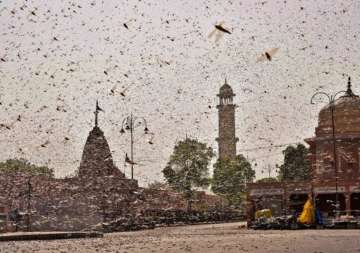A large part of northern India is facing severe locust attacks or a swarm invasion if we may say so. And, the timing couldn't be worse. It comes at a time when the country already has a humongous task at hand as posed by the coronavirus crisis. Rajasthan, Madhya Pradesh, Gujarat, Haryana, and Punjab are among the states badly hit by these locust swarms that came attacking, often sparking doomsday speculations. Vidharba in Maharashtra, Mathura in Uttar Pradesh, and New Delhi also haven't remained untouched by these locust swarms. Experts have claimed it to be the worst attack in nearly 26 years. Even though they don't bite humans, it still may keep you on tenterhooks.
WHAT IS A LOCUST SWARM
Locusts are insects that travel in large swarms. They devastate crops, thereby causing major agricultural damage, also leading to the possibility of famine and starvation. Locusts can travel up to 150 kilometers in a day depending on the wind speed. These insects fly during the day and are known for feasting on all sorts of plants and standing crops. They destroy flowers, fruits, leaves, seeds, bark, and growing points. It is said that a small swarm of the desert locust eats as much food in one day as about 10 elephants, 25 camels, or 2,500 people.
In this photo taken March 31, 2020, desert locusts swarm over a tree in Kipsing, near Oldonyiro, in Isiolo county, Kenya.
WHY YOU SHOULD BE WORRIED
India has been a victim of locust plagues and upsurges from 1812 to 1997. However, there have been no locust upsurges since December 2011. As per the data available with the Union Agriculture Ministry, locusts damaged crops worth Rs 10 crore during the 1926-31 plague cycle. The damage, during the 1940-46 and 1949-55 locust plague cycles, was estimated at Rs 2 crore per cycle while also causing destruction worth Rs 50 lakh between 1959-62. As per government records, 190 locust swarms had attacked an area of about 3,10,000 hectares in Jaisalmer, Barmer, Bhuj, and Jalore districts of Rajasthan in 1993. Even as these locust attacks were earlier largely restricted to Rajasthan, this time around favorable weather conditions have enabled their travel to other states as well. The history serves quite as a lesson.
Since these insects attack crops, it is definitely going to affect us. If these locust attacks persist, there is a possibility that these insects will rob the agricultural sector of lakhs of tonnes of food grains and vegetables. Then, it also may become very likely that the on-the-edge economy will plunge further. The United Nations has said that there is a severe risk to the Indian agriculture sector this year because of such attacks. According to the United Nations' food and agriculture organization (FAO), the locust infestation is likely to get severe by next month. The desert locust invasion is expected to move from East Africa to India and Pakistan next month.
ALSO READ | Locust attacks in India: Terrifying photos, videos of one of the worst swarm attacks emerge
ALSO READ | Locust attacks in Rajasthan: Drones, planes to be used to fight locust swarms
RELATED VIDEO
Latest India News
